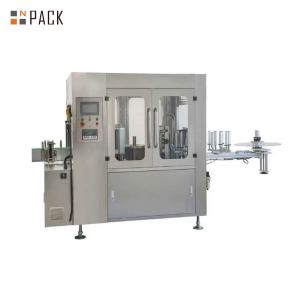

Add to Cart
Automatic Opp Hot Melt Glue Labeling Machine
For comprehensive labeling of cut paper or film labels from the magazine, we employ a specialized hot glue system that transfers the glue without direct contact. Alternatively, initial and final label adhesion can be applied point by point using spray glue onto the vacuum drum. This system offers the advantage of minimal glue consumption and reduced machine contamination.
Thanks to the utilization of hot glue, this system is also well-suited for processing cans and containers made of tinplate.
The automatic hot melt glue labeling machine is widely utilized for various container materials and labels. With comparatively lower label costs, it can fulfill the needs of users with diverse container requirements.
It represents the most cost-effective option for mass production. The equipment incorporates a modular design concept, facilitating easy bottle changes for users. The linear type primarily labels round bottles made of glass or plastic, while the rotary type can label not only round containers but also square bottles such as liquid detergent containers, etc.
Main Feature
1. This system is designed for precise adhesive application,
utilizing localized glue methods, resulting in minimal glue
consumption and low operational costs.
2. Thanks to its high-precision design, the machine can achieve
high-speed operation.
3. The labeling station serves as the core component, ensuring
constant tension during trademark transmission, automatic trademark
correction, and internal synchronization of labeling speed.
Additionally, it facilitates easy replacement of label types.
4. The cam design simplifies bottle type replacement, while
pneumatic nose clamping enhances host convenience.
5. Comprehensive automation and control are achieved through PLC
control, servo systems, inverter systems, temperature control
systems, and other integrated control points.
6. Complete overload and security protection features, including
multiple fault protection devices, ensure enhanced man-machine
safety.
7. The centralized lubrication system simplifies machinery
lubrication, ensuring prolonged machine life and easy maintenance.
8. A specially designed folder structure ensures flexible and
compact folding of trademarks.
9. Servo motor-driven traction ensures timely, accurate, and neat
cutting of trademarks, aided by photoelectric color code detection
and compensation.
10. Biaxial screw propeller mechanisms facilitate stable and smooth
bottle feeding at high speeds.
11. The local bottle inflation function accommodates containers
with lower weight, reducing operating costs for users.
12. The double disk structure minimizes membrane replacement time,
maximizing machine productivity and effective production duration.
13. A constant tension membrane material detection and feedback
control system ensures high-quality labeling with various membrane
materials.
14. This fully automatic labeling machine is tailored for
economical wrap-around labeling of glass, plastic, and metal
containers of various shapes and sizes.
Wrap-around labeling with pre-cut paper or plastic labels eliminates the need for a gluing drum. The hot melt is applied economically as spots onto the container through high-pressure nozzles, and the container takes the label directly from the magazine.
The final gluing is done by a continuous vertical glue strip. This economical and clean gluing method not only saves on change parts and components but also minimizes daily cleaning requirements.
Parameter
| Model | NP-HGL |
| Suitable bottle volume | 265ml±4ml |
| Speed | 6000 bottle/hour |
| Bottle shape | Round bottle |
| Bottle diameter: | 55mm-100mm |
| Label exact: | 2mm |
| Applicable material of label | PAPER, PP, BOPP, OPP, PVC, PE, ETC |
| Applicable material of bottle | PE, PET, Glass bottle, POP Can |
| Power | 308 VOLTS, 3 PHASE, 50-60 HZ, 9 -12 KW |
| Air consumption | 4Mpa |
| Weight | 1500 Kg |
| Dimension of machine | L5000 × W1800 × H2000 mm |
Guidelines for Installation of Hot Melt Labeling Machine:
Basic Regulations:
1. Upon machine arrival, installation personnel must visually
inspect for any damage, such as frame deformation or cabinet
dampness. If uncertain, contact the manufacturer for assessment.
Promptly notify the transport company if any damage is found.
2. Exercise caution when unpacking to avoid environmental damage.
3. Use lifting equipment like forklifts carefully to prevent
sliding or imbalance.
4. Prior to using lifting equipment, inspect parts under the
working table carefully or seek guidance from experienced workers.
5. Avoid using cables to lift the machine.
6. Installation personnel are prohibited from connecting the
machine to a power supply.
Operator Guidelines:
1. Refrain from operating the machine under the influence of
tranquilizers, medications, or alcohol.
2. Have a thorough understanding of the machine's mechanism,
functions, control knobs, and devices before operation.
3. Only operate the machine with proper authorization or
permission.
4. Pay attention to warnings or signs at all times.
5. Do not initiate machine operation in case of abnormal pressure
onsite.
6. If the machine suddenly stops working, do not restart it. Seek
assistance from a trained technician to identify and resolve the
issue.
7. Maintain a safe distance from moving parts until the machine
stops completely.
8. Do not remove safety guards from the machine.
Maintenance Protocol:
1. Avoid performing maintenance on the working table while the
power is on.
2. Only conduct maintenance on electric elements after opening the
main circuit breaker and switching off the main power.
3. Handle touching parts carefully to prevent damage or
displacement.
4. Ensure no tools are left on the working table when the machine
is operating independently.
5. Do not use flames or hammers on any part of the machine.
6. Do not attempt to measure or modify any parts independently to
prevent damage. Contact the seller for spare parts as per the
guarantee.
Cleaning and Maintenance:
1. Cleaning the labeling machine can be performed by individuals
without mechanical/electrical expertise, provided they receive
proper training. Ensure the power is turned off during cleaning.
2. Individuals with knowledge of mechanics and electricity are at
lower risk during maintenance tasks.
3. Skilled and trained workers are strongly recommended for machine
maintenance.
4. Maintenance involves various aspects such as mechanics,
electricity, and motors.
